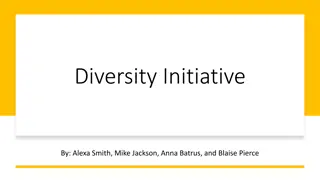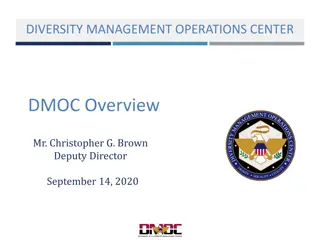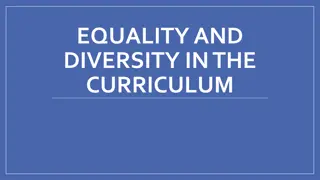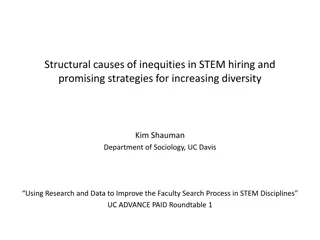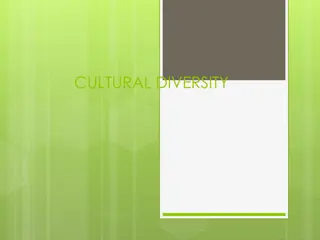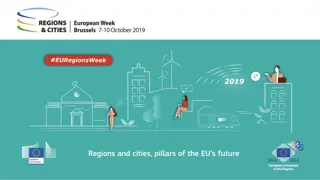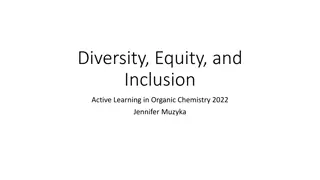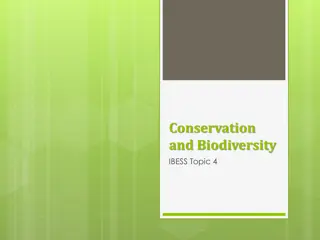
Enhancing Teaching Activities for Diverse Student Success
Explore strategies to support a diverse student body thrive in educational settings through activities focusing on cultural understanding, student behaviors, and addressing the achievement gap, with insights on why underrepresentation persists in STEM fields. Reassessing challenges and implementing the multicontext model to promote full participation from all students.
Uploaded on | 2 Views
Download Presentation

Please find below an Image/Link to download the presentation.
The content on the website is provided AS IS for your information and personal use only. It may not be sold, licensed, or shared on other websites without obtaining consent from the author. If you encounter any issues during the download, it is possible that the publisher has removed the file from their server.
You are allowed to download the files provided on this website for personal or commercial use, subject to the condition that they are used lawfully. All files are the property of their respective owners.
The content on the website is provided AS IS for your information and personal use only. It may not be sold, licensed, or shared on other websites without obtaining consent from the author.
E N D
Presentation Transcript
Ways to Change Your Teaching Activities to Help Our Diverse Student Body to Thrive Gary Weissmann and Roberto Ibarra University of New Mexico
Our Path for the Next Three Days Day 1: Who am I and how does that influence my teaching? Cultural Autobiography foundational for next days. Day 2: Who are my students? Where are they coming from? Multicontext model of diversity Day 3: My classroom mode: How can I enhance full participation from a diverse group of students? Applying the Multicontext model
Classroom Behaviors Activity 4 In your assigned group: Discuss classroom behaviors that are: Beneficial to student success in the classroom Are not beneficial to student success in the classroom Recordthese observations on your group s workpage (in the Private Workspace).
Classroom Behaviors Backup Activity 4 Write a brief evaluation for each of the student behaviors and include: 1. The frequency of the observed behavior in your classes (often, sometimes, infrequent, never). 2. Your opinion about why this behavior is observed in the classroom
What are other student behaviors observed in your classes?
A Critical Question About Diversity in Education in the US Today: Why, despite long-term efforts by affirmative action programs, do many segments of the national population remain grossly underrepresented, especially in STEM fields? 1996: The issue involves the achievement gap.
Reassessing the Problem: The Achievement Gap Bowen & Bok Shape of the River (1998) Demonstrated Affirmative Action works but even accounting for all variables, gaps in academic performance among various groups still exist. Average class rank in their graduating class: African Americans: 23rd percentile; Hispanics: 36th percentile, Majority students: 53rd percentile. Found social/cultural factors that reduce the gaps people-oriented relationships, family/community engagement, supportive psychological environments, working in groups, collaborative learning environments, etc.
The problem lies in the origins of academic culture! The context of higher education in the U.S. is locked into a centuries-old German research model imported from Europe and clamped on a British colonial college system; The predominance of a particular and preferred learning environment tends to exclude all others, and thus defines the cultural context of higher education today; The outcome is not only a Euro-centric learning community, but also a hidden dimension of cultural context that has been an invisible element of diversity ignored until now.
The Emerging Multicontext World In the 1960 s, anthropologist Edward T. Hall identified a variety of national origin cultures that exhibited learned preferences or Cultural Contexts that influence how: one interacts and associates with others, uses living space, perceives concepts of time, processes information, responds to a various teaching and learning styles, Performs academically or in the workplace, and Includes many other cognitive factors that were imprinted on them in childhood by family and community and continue to help shape their world view throughout their lives.
The Emerging Multicontext World Definition of Cultural Context : Hall defined it as inter-cultural communication based on observations of interpersonal transactions across a wide variety of cultural interfaces. That transaction takes account of how information is handled and how cultural messages are transmitted. Cultural context translates behavior into meaning why do people do what they do and how that affects everything around us both consciously and unconsciously. Cultural Hidden Dimensions.
The Emerging Multicontext World Using a binary model, Hall identified some populations, mainly Northern European cultures (English, German, Swiss, and Scandinavian people) as Low Context (LC)cultures because they required little contextualization to communicate, interact, and interpret the world around them.
The Emerging Multicontext World Hall also identified some populations (including Asians, Arabs, people from other Middle Eastern and Mediterranean-based countries, Africans, Latin Americans, and North American Indian groups) as High Context (HC)cultures because they required more social and cultural contextualization to communicate, interact and interpret the world around them.
The Emerging Multicontext World U.S. populations are varied and still exhibit to varying degrees the low or high context imprinting of their ethnic heritage. Although high context populations are increasing in the U.S. today, mainstream American culture and core values are primarily low context. North American men are generally, but not always, found to be more low context than North American women.
The Emerging Multicontext World 1990 s research on Latinos revised the cultural context model (Ibarra 2001): Diverse populations in the U.S. higher education are not necessarily predominantly HC or LC but instead are MULTICONTEXTUAL a learned ability to survive in LC academic culture while maintaining HC characteristics in other aspects of life.
The Emerging Multicontext World Since WWII, the GI Bill opened doors to a variety of populations, including those with different religious faiths, women, and underrepresented groups who tended to bring Multicontextual experiences that are quite different, and even at odds with the cultural context of academe and even many workplace environments. These individuals tended to under-perform academically or possibly drop out but they also have had an impact on changing the academic cultures in many institutions.
The Emerging Multicontext World Although the cultural context model was never applied to examine organizational cultures in the past, applying the Multicontext model today reveals that higher education is predominantly a LC culture derived from the 19th century German research institute model that grounded graduate and professional training over the last century. The resulting conflict between LC academic culture and HC cultural preferences causes the dissonance we note among underrepresented groups.
Clues about how to increase diversity in STEM emerged in 1970s with Uri Treisman sMathematics Workshop showing group study increased academic success among minority students. The reason was never understood.
Cultural Context Components & Functional Levels 1.Interaction Micro level: Individual or workplace/classroom Workplace, campus, community Time orientation Use of space and place Networks, information flow, and cognition Gender orientation Learning styles and cognition 2. Association 3. Temporality 4. Territorality 5.Information 6. Gender/Culture 7. Learning 8. Academic systems Macro level: Institutional level characteristics (predominantly LC)
Low Context High Context MC Interaction Interaction Emphasis on words to supply meaning & low use of non-verbal signals Communication is direct High use of non-verbal signals with words to contextualize meaning. Communication is indirect Disagreement is personalized Disagreement is depersonalized
High Context (HC) Low Context (LC) Task Words Gestures Situation: Meeting Social Status Social Setting Tone History Posture High and Low Context Communication Edward T. Hall- Beyond Culture /Dance of Time
Context Diversity: Helping the system adjust to people An emerging transformative paradigm that emphasizes reframing rather than reforming organizational cultures to meet the needs of all populations and especially underrepresented groups. The dynamic effect is to create a community with myriad ways to attract diverse populations and have them thrive in an academic or workplace environment.
Context Diversity Is associated with systemic change in the core organizational cultures, not just programmatic change. It shifts diversity initiatives from current concepts about recruitment and retention to concepts that emphasize attracting and thriving ( People want to be here ) or reframing rather than reforming.
Context Diversity It also shifts the focus from people as the source of conflict to the institutional and organizational cultures as the source of conflict. It should not be associated with concepts of institutional racism, which are often policies used by dominant groups to subjugate subordinate groups.
Context Diversity Results are measured not only by how well we attract diverse populations, but also by how well we enhance our campus climate and cultures to improve upon the academic and work performance among all students, faculty, and staff. Objective: Build diversity into the context of our higher education system, our learning communities, and beyond.
Recent Additional Work Published Ch vez and Longerbeam, 2016 Focuses on applications in the classroom Low Context = Individuated High Context = Integrated
Chvez and Longerbeam, 2016 Individuated In a culturally individuated framework, a private compartmentalized, linear, contextually independent conception of the world is common, assumed, and valued. Integrated In a culturally integrated framework, an interconnected, mutual, reflective, cyclical, contextually dependent conception of the world is common, assumed, and valued. Purpose of learning: Knowledge, individual competence, to move forward toward goals and the betterment of humanity. Purpose of learning: Wisdom, betterment of the lives of those with whom we are connected family, tribe, community. Ways of taking in and processing knowledge: Mind as primary, best or only funnel of knowledge. Ways of taking in and processing knowledge: Mind, body, spirit/intuition, reflection, emotions, relationships as important aspects and conduits of knowledge. Interconnectedness of what is being learned: Compartmentalized and separate; belief that understanding how the parts work separately, abstractly and in isolation will lead to the greatest understanding. Interconnectedness of what is being learned: Contextualized and connected; belief that understanding how things affect each other within the whole and within family and community will facilitate understanding. Time: Linear, task-oriented, can be measured and used, to be on time shows respect. Time: Circular, seasonal, process oriented, dependent on relationships; to allow for enough time shows respect. Sequencing: Learning by mastering abstract theory first, followed by testing; unlikely to include application, experience or doing in real life. Sequencing: Learning by doing, listening to others experiences, imagining, or experiencing first, then drawing out abstract theory.
Take a minute Individually, think about: How do yourclassroom behaviors relate to context theory. Activities, teaching philosophy, expectations, etc. How might context play a role in forming these behaviors? Record these observations in your notebook. You might want to use the Context Diversity handouts and postings to help with this.
Classroom Behaviors Activity 5 Back in your assigned group: Evaluate classroom behaviors relative to context theory. How might context play a role in forming these behaviors? Recordthese observations on your group s workpage (in the Private Workspace). You might want to use the Context Diversity handouts and postings to help with this.
Classroom Behaviors Discussion and reporting
Traditional view of developmental students Un- or under-prepared Lacking classroom, academic, literacy, and/or mathematical skills. Inattentive or unable to retain information.
Traditional view of developmental students Unable to extend skills across time and/or space. Conceive knowledge as a thing given to them rather than a thing they create. Unable to move beyond the personal in their relationship to information.
View of developmental students through a Multicontextual lens Prepared in a different knowledge context, one that emphasizes integrated (contextualized), experiential knowledge. Their knowledge context depends on an interpersonal, community framework. Their skill strengths exist, but in areas often unrecognized in academic/professional settings.
View of developmental students through a Multicontextual lens Their literacy skills are often a result of a verbal rather than a written literacy community. Their mathematical/scientific skills are often a result of experimental rather than abstracted knowledge. Through their prior schooling and institutional experiences, they have come to anticipate a lack of relevance of school knowledge, thus they are inattentive.
View of developmental students through a Multicontextual lens Their anticipation of the irrelevance of school knowledge leads them to compartmentalize what they learn and apply it only to restricted contexts. Their experience with authoritarian learning environments leads them to conceive of learning as something given to them by those in authority (top to bottom authoritarian structure). Students who are not engaged become alienated, inattentive, and unsuccessful.
Day 2 Road Check Please go to the Day 2 Road Check at the bottom of the Program Schedule page. Your comments will help us make any needed adjustments tomorrow. THANKS! SEE YOU TOMORROW!


